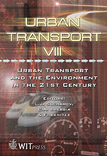Container Railcar Versus Container Lorry Transport - A Comparative Study
Price
Free (open access)
Transaction
Volume
60
Pages
10
Published
2002
Size
405 kb
Paper DOI
10.2495/UT020681
Copyright
WIT Press
Author(s)
F.R. Haferkorn
Abstract
The system advantages of rail transport: minimal rolling resistance, trains of any length with excellent wind shadowing, small motive performance required and energy consumed high velocity, safety and reliability (just in time) and automated operation may all be derived from the strong connection of steel wheels to steel rails. They make railway transport economically and environmentally acceptable. We have used our simulation tool AERORAIL and the Dortmund formulae to calculate air resistance of vehicles and trains. This tool was tested with data from simulations, measuring series in wind tunnel and literature and until now proved to be correct. Nevertheless vehicles and systems based on formula calculations have to be tested as scale prototypes and in pilot projects in real reality. The recently developed container railcar CargoSprinter was compared to container transport on lorries using the interport line between Rotterdam and Kaliningrad as a background. Our economic calculations depend on a system of technical cost indicators: Number of trains/lorries required as a model for staff costs, motive performance installed for depreciation and motive performance applied for operational costs. Limitations were an overall transport impulse of 1 million tkm/h and a heavy lateral storm adding continuously 80 km/h to the rolling velocity. Railway trains, especially the streamlined version, showed much more efficiency than lorries. Of course we omitted infrastructure costs for both competitors, trains and lorries. In Germany rail customers are exempt from such costs only during pilot projects.
Keywords





